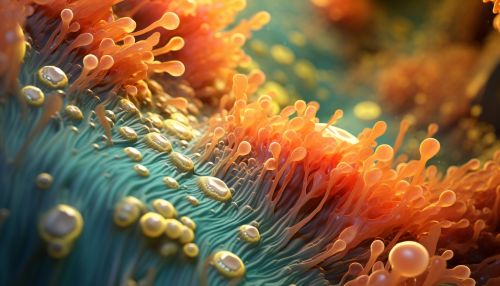Thermotaxis
Introduction
Thermotaxis is a behavior exhibited by organisms that allows them to move towards or away from a heat source. It is a type of taxis, which is a response to external stimuli. Thermotaxis is observed in various organisms such as bacteria, nematodes, and even in mammals. This behavior is crucial for the survival of these organisms as it helps them to maintain their optimal body temperature.


Mechanism of Thermotaxis
The mechanism of thermotaxis varies among different organisms. In bacteria like E. coli, thermotaxis is mediated by a group of proteins known as methyl-accepting chemotaxis proteins (MCPs). These proteins can sense changes in temperature and relay this information to the flagellar motor, causing the bacteria to move towards or away from the heat source.
In the nematode C. elegans, thermotaxis is controlled by a neural circuit consisting of a sensory neuron, interneurons, and motor neurons. The sensory neuron, known as AFD, can detect changes in temperature and transmit this information to the interneurons. The interneurons then relay this information to the motor neurons, which control the movement of the worm.
In mammals, thermotaxis is mediated by the thermoreceptors present in the skin and the hypothalamus. These receptors can detect changes in external and internal temperature, respectively, and send this information to the brain. The brain then initiates appropriate responses to maintain the body's optimal temperature.
Role in Survival
Thermotaxis plays a crucial role in the survival of organisms. For bacteria, thermotaxis allows them to find optimal growth conditions. For example, E. coli prefers to grow at temperatures around 37°C, which is the human body temperature. By moving towards this temperature, E. coli can increase its chances of survival and reproduction.
For C. elegans, thermotaxis allows them to find their preferred temperature, which is around 20°C. This behavior is crucial for their survival as it allows them to avoid harmful temperatures.
In mammals, thermotaxis helps to maintain the body's optimal temperature, which is crucial for the proper functioning of various physiological processes. For example, if the body's temperature is too high, it can lead to heat stroke, while if it's too low, it can lead to hypothermia.
Applications of Thermotaxis
The study of thermotaxis has various applications in different fields. In microbiology, the study of thermotaxis in bacteria can help to understand their behavior and survival strategies. This can be useful in developing strategies to control bacterial infections.
In neuroscience, the study of thermotaxis in C. elegans can help to understand how neural circuits process sensory information and generate behavioral responses. This can provide insights into the functioning of the human brain.
In medicine, the study of thermotaxis in mammals can help to understand how the body maintains its optimal temperature. This can be useful in developing treatments for conditions related to temperature regulation, such as hypothermia and heat stroke.
